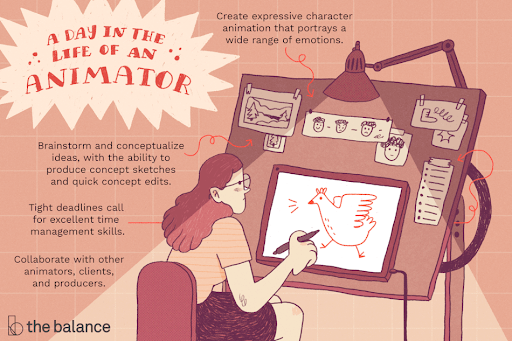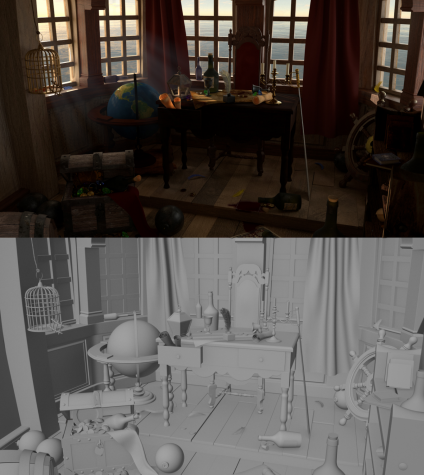What Does it Take to Be an Animator?

This article is for anyone who wants to know what an animator is and what exactly it is that they do. Or, more specifically, for all of my friends and family members that get a very puzzled look on their face when they ask me what I want to do, and I tell them animation.
An animator’s job title can be defined as a multimedia artist who creates animation and visual effects for everything from films and video games to television, mobile devices, and other forms of media using illustrations and software programs. They often specialize in one of those forms of media and, further, can have a concentration in a particular area, such as 2D or 3D animation, background art, character design, lighting, scenery, special effects, advertising, modeling, and so much more. According to Animation Career Review, “They create, plan, and script animated narrative sequences and assist with background design and production coordination.”
An animator’s duties and responsibilities can include:
- Using computer programs and illustrations to create graphics and animation.
- Researching upcoming projects to create realistic designs and animations.
- Creating expressive character animation that portrays a wide range of emotions.
- Collaborating often with other animators, clients, and producers.
- Brainstorming and conceptualizing ideas with the ability to produce concept art and develop storyboards.
- Comprehending and executing direction from the lead animator or animation supervisor.
To fulfill these daily responsibilities, animators require artistic talent, communication and interpersonal skills, computer skills, creativity, and time management skills. Animators and artists often depend upon their artistic ability and need a good understanding of color, texture, and lighting. Although, good technical skills and a strong knowledge of software can compensate for a lack of artistic ability. Multimedia artists and animators work as part of a complex team, requiring valuable communication and interpersonal skills to respond well to criticism and feedback and give constructive criticism to fellow team members. Possessing proficient, if not expert, computer skills is another essential part of being an animator. Animators need to understand and work with state-of-the-art programs to complete most of their work. Moreover, creative thinking and a visual imagination is a crucial prerequisite. They need to be able to generate original ideas and bring them to fruition. It is additionally vital that animators and multimedia artists have good time management skills to meet required deadlines. Most studios and game design companies call for long hours, particularly when tight deadlines need to be met, and failure to meet these deadlines can cost companies a lot of money.
Now, you might be wondering what kind of education is required of an animator? What would it even be called? What do employers look for in job applicants? First off, an animator isn’t required to have a college degree; however, most employers prefer to hire applicants who have a bachelor’s degree in animation, computer graphics, fine arts, or a related discipline. There are so many options out there for degrees related to animation; there are even specific degrees for those who want to create animation for video games (video game design and interactive media). Most importantly, though, employers look for applicants who have a strong portfolio of work and solid technical skills. Nowadays, countless colleges and universities offer excellent animation programs, and a myriad of online courses can teach you the necessary skills. When pursuing a degree in animation or a related field, coursework can involve painting, drawing, and sculpting. Specific classes can include but are not limited to 3D animation, 3D design and modeling, digital cinema production, digital sound design, editing, hand-drawn animation, art history, illustration, motion graphics, screenwriting, and storyboarding.
I interviewed Jordan Gustovich, a student at Drexel University who is pursuing a Bachelor of Science in Animation and Visual Effects (VFX). She shared some first-hand information on what it’s like to be an animation major and what the coursework includes. Jordan shared that “Drexel’s curriculum exposes its students to a wide variety of ways to use animation and VFX within the industry. We start with learning the basics of industry-used software such as Autodesk Maya, Adobe After Effect, Photoshop, Premiere Pro, Substance Painter, and Foundry Nuke… During our first year, we take traditional/digital art classes, learn about basic cinematography, how to create 3D models and the basics of compositing film footage. In the courses where we make 3D models, we also learn how to light, texture, and render the scenes we create.” In Animation 1, students must create a single object of their choosing. In Animation 2, they move on to creating a whole environment (the amazing environment that Jordan created can be seen below). In years two and three, students at Drexel move on to learning the foundations of character animation and start by bringing inanimate objects to life. Some of the assignments for these classes include creating a robot and an environment that follow a short story. Further, students dive into body mechanics, the 12 principles of animation, facial animation, and lipsync. “For [our] senior year, all students are responsible for forming teams and working on a senior project. This project is meant to display all of the skills that we have learned over the past four years by creating a 2-3 minute short story from scratch.” Like many other universities, Drexel also offers classes that allow students to expand their skill sets even further in areas like compositing and special effects. When asked what it’s like to be an art major, Jordan replied, “being an art major is a lot of fun. There is a great deal of creative freedom that we are given, allowing for the projects we work on to be enjoyable and something we want to do. At times it can be a lot of work, and projects may take 20+ hours, but the outcome of those projects is worth it.”
Now that we’ve covered what precisely an animator is, what they do, and the skills and education required, let’s dive into what it’s like to be one. A day in the life of an animator involves patience and skill but is also full of reward and artistic expression. It is undoubtedly a dream job for many people, though it’s not all fun and games. Many animators work for large production companies like Disney or Dreamworks, which reside in a very competitive industry that must adhere to strict time constraints. Art takes time, but animators have to learn to work fast. Many days also involve patience; there are often tedious and repetitive animating tasks that go into creating an end product. Animators work in teams to create end products like movies, tv shows, video games, and more. Each animator works on a portion of the project, and then the pieces are compiled in editing to create one cohesive animation.
Mr. Sudac, the 3D Animation and Digital Design teacher here at PHS, was able to give me some insight into what it’s like to work in the animation industry. Before his days teaching here at Pennridge, Mr. Sudac worked as an animator and art director at Nickelodeon. His job was to take scripts and turn them into visualizations. He had to read a script, sketch out a storyboard (which involved figuring out the animation and character movements), block out the shots and what he wanted each one to look like, and then meet with his team. There, they would have an idea session and discuss what everyone was going to be working on. After that, everyone would go in their own direction and work on individual assignments, and he would oversee the process. Mr. Sudac described working in the animation industry as a competitive but fun work environment. Everyone was constantly trying to improve their craft, and there were always deadlines to meet. His favorite part of the job was, of course, the creativity that is called for. But, he cautioned that, in the industry, you have to report to and collaborate with others and won’t always have creative free reign. Overall, Mr. Sudac advises that one must always be prepared to bring their A-game when working as an animator. Just because it’s such a fun and creative work environment doesn’t mean that there isn’t a lot of work to be done. He also advised that you have to be ready to learn something new every day. Animation is a constantly evolving field, and there’s always room for improvement, whether in artistic ability, technical skills, or time management skills. And to those who hope to pave their way in the wonderful world of animation, Jordan Gustovich was also able to offer some first-hand advice; “I would say to always have an open mind and be willing to learn and try new things. The limits of animation are endless; there are a lot of techniques and skillsets to learn. And remember to have fun with it!”










